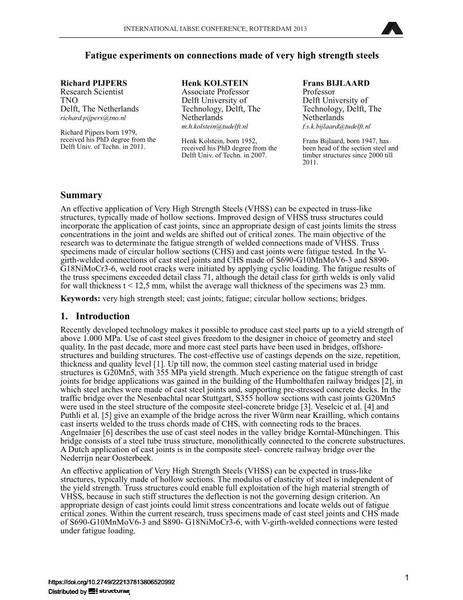Fatigue experiments on connections made of very high strength steels

|
|
|||||||||||
Bibliographic Details
| Author(s): |
Richard Pijpers
Henk Kolstein Frans Bijlaard |
||||
|---|---|---|---|---|---|
| Medium: | conference paper | ||||
| Language(s): | English | ||||
| Conference: | IABSE Conference: Assessment, Upgrading and Refurbishment of Infrastructures, Rotterdam, The Netherlands, 6-8 May 2013 | ||||
| Published in: | IABSE Conference, Rotterdam, May 2013 | ||||
|
|||||
| Page(s): | 438-439 | ||||
| Total no. of pages: | 8 | ||||
| Year: | 2013 | ||||
| DOI: | 10.2749/222137813806520992 | ||||
| Abstract: |
An effective application of Very High Strength Steels (VHSS) can be expected in truss-like structures, typically made of hollow sections. Improved design of VHSS truss structures could incorporate the application of cast joints, since an appropriate design of cast joints limits the stress concentrations in the joint and welds are shifted out of critical zones. The main objective of the research was to determinate the fatigue strength of welded connections made of VHSS. Truss specimens made of circular hollow sections (CHS) and cast joints were fatigue tested. In the V- girth-welded connections of cast steel joints and CHS made of S690-G10MnMoV6-3 and S890- G18NiMoCr3-6, weld root cracks were initiated by applying cyclic loading. The fatigue results of the truss specimens exceeded detail class 71, although the detail class for girth welds is only valid for wall thickness t < 12,5 mm, whilst the average wall thickness of the specimens was 23 mm. |
||||
| Keywords: |
bridges fatigue circular hollow sections cast joints very high strength steel
|
||||
